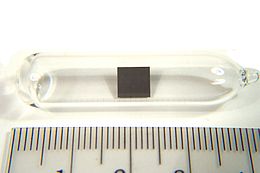
Thorium-based nuclear power generation is fueled primarily by the nuclear fission of the isotope uranium-233 produced from the fertile element thorium. A thorium fuel cycle can offer several potential advantages over a uranium fuel cycle[Note 1]—including the much greater abundance of thorium found on Earth, superior physical and nuclear fuel properties, and reduced nuclear waste production. One advantage of thorium fuel is its low weaponization potential. It is difficult to weaponize the uranium-233 that is bred in the reactor. Plutonium-239 is produced at much lower levels and can be consumed in thorium reactors.
After studying the feasibility of using thorium, nuclear scientists Ralph W. Moir and Edward Teller suggested that thorium nuclear research should be restarted after a three-decade shutdown and that a small prototype plant should be built.[1][2][3] Between 1999 and 2022, the number of operational thorium reactors in the world has risen from zero[4] to a handful of research reactors,[5] to commercial plans for producing full-scale thorium-based reactors for use as power plants on a national scale.[6][7][8][5][9]
Advocates believe thorium is key to developing a new generation of cleaner, safer nuclear power.[8] In 2011, a group of scientists at the Georgia Institute of Technology assessed thorium-based power as "a 1000+ year solution or a quality low-carbon bridge to truly sustainable energy sources solving a huge portion of mankind's negative environmental impact."[10] However, development of thorium power has significant start-up costs. Development of breeder reactors in general (including thorium reactors, which are breeders by nature) will increase proliferation concerns.
Cite error: There are <ref group=Note> tags on this page, but the references will not show without a {{reflist|group=Note}} template (see the help page).
- ^ Moir, Ralph W. and Teller, Edward. "Thorium-fuelled Reactor Using Molten Salt Technology", Journal of Nuclear Technology, September 2005 Vol 151 (PDF file available). This article was Teller's last, published after his death in 2003.
- ^ Hargraves, Robert and Moir, Ralph. "Liquid Fluoride Thorium Reactors: An old idea in nuclear power gets reexamined" Archived 25 February 2021 at the Wayback Machine, American Scientist, Vol. 98, p. 304 (2010).
- ^ Barton, Charles. "Edward Teller, Global Warming, and Molten Salt Reactors" Archived 12 November 2020 at the Wayback Machine, Nuclear Green Revolution, 1 March 2008
- ^ "Uses For Uranium-233: What Should Be Kept for Future Needs?" (PDF). 27 September 1999. Archived (PDF) from the original on 23 July 2021. Retrieved 30 March 2020.
- ^ a b Shen, Alice (10 January 2019). "How China hopes to play a leading role in developing next-generation nuclear reactors". sg.news.yahoo.com. Archived from the original on 14 June 2021. Retrieved 22 May 2021.
- ^ Thorcon design document: (2010) Powering up our world with cheap, reliable, CO2-free electric power, now. Archived 20 May 2021 at the Wayback Machine
- ^ World Nuclear News (26 Jan 2022) Empresarios Agrupados contracted for first ThorCon reactor
- ^ a b Use Molten salts— Flibe both as fuel and as coolant transfer fluid: (2020) Molten-Salt Reactor Choices - Kirk Sorensen of Flibe Energy Archived 13 February 2021 at the Wayback Machine. Keep operational temperatures below 700 °C, use prismatic graphite as moderator, pump the molten salts from one reactor vessel in cooldown stage to the active, operating reactor vessel. Mitigate tritium using the CO2 cycle in the supercritical CO2 power conversion system; capture the tritium with the oxygen in the supercritical CO2 as mitigated water. This approach keeps the materials in chemical equilibrium during the process, while reducing the volume of waste materials such as CO2, with shorter radioactive half-lives than the uranium series' half-life.
- ^ Cite error: The named reference
WNA090822was invoked but never defined (see the help page). - ^ Cooper, Nicolas (2011). "Should We Consider Using Liquid Fluoride Thorium Reactors for Power Generation?". Environmental Science. 45 (15): 6237–38. Bibcode:2011EnST...45.6237C. doi:10.1021/es2021318. PMID 21732635.
© MMXXIII Rich X Search. We shall prevail. All rights reserved. Rich X Search
